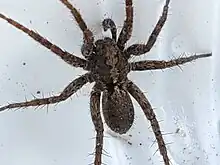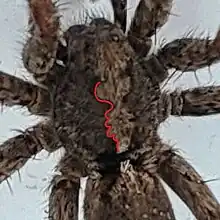| Pardosa astrigera | |
|---|---|
 | |
| Scientific classification | |
| Domain: | Eukaryota |
| Kingdom: | Animalia |
| Phylum: | Arthropoda |
| Subphylum: | Chelicerata |
| Class: | Arachnida |
| Order: | Araneae |
| Infraorder: | Araneomorphae |
| Family: | Lycosidae |
| Genus: | Pardosa |
| Species: | P. astrigera |
| Binomial name | |
| Pardosa astrigera (Koch, 1978) | |
Pardosa astrigera is a species of wolf spider in the family Lycosidae.[1] They are found throughout Japan, Korea, China, Taiwan, and far east Russia.[1][2][3][4][5][6]
Description
Pardosa astrigera is a small wolf spider with the body length ranging between 6–10 mm (0.24–0.39 in) for females and 5–9 mm (0.20–0.35 in) for males.[2][3][4] The cephalothorax varies from blackish-brown to yellowish-brown with a distinct median dorsal stripe running the length of the carapace.[1][3][4] White setae are typically present on the pedicel.[1][2] The sternum is blackish-brown.[1][4] The abdomen varies from blackish-brown to yellowish-brown, with a subdued brownish-yellow longitudinal dorsal stripe.[1][4] There is a high degree of variation in the dorsal pattern on the abdomen, however the typical presentation includes several thin lateral chevrons and 5 pairs of spots along the margins.[1][2][4][5] The ventral side of the abdomen is yellowish-brown with a blackish-brown middle.[1][2][4][5]
Identification
Descriptive diagnostic features with illustrations can be found in Koch 1878,[1] Saitō 1939,[7] and Namkung 2003.[4] Diagnostic photographs are provided in Baba and Tanikawa 2015[3]
Visual Identification

Pardosa astrigera is one of the few spiders that can be identified at a glance, as these spiders have a unique longitudinal band on the median of the carapace.[2][3] The band is yellowish-brown in color, rounded behind the eyes, forming a star shape around the fovea, and narrowing as it reaches the abdomen.[1][3]
Habitat
Pardosa astrigera have been found on plains, mountains, paddy fields, open grasslands, riverbanks, and other areas. They are often found in relatively dry regions.[2][3][4]
Seasonality
Adult males and females can be found from spring to autumn.[3]
Synonyms
- Lycosa astrigera (Bösenberg & Strand, 1906: p.322)[8]
- Lycosa T-insignita (Bösenberg & Strand, 1906: p.324)[8]
- Tarentula phila (Dönitz & Strand, in Bösenberg & Strand, 1906: p.389)[8]
- Lycosa cinereofusca (Dönitz & Strand, in Bösenberg & Strand, 1906: p.393)[8]
- Lycosa sagibia (Strand, 1918: p.85)[9]
- Pirata aomorensis (Saito, 1939: p.71)[7]
- Pardosa cinereofusca (Roewer, 1955: p.161)[10]
- Pardosa sagibia (Roewer, 1955: p.172)[10]
- Pardosa T-insignita (Roewer, 1955: p.174)[10]
- Avicosa aomorensis (Roewer, 1955: p.234)[10]
- Lycosa philia (Roewer, 1955: p.269)[10]
- Pardosa pseudochionophila (Schenkel, 1963: p.357)[11]
- Pardosa fiusignita (Wang, 1981: p.123)[12]
References
- 1 2 3 4 5 6 7 8 9 10 Koch, Ludwig (October 3, 1877). "Japanesische Arachniden und Myriapoden". Verhandlungen der Kaiserlich-Königlichen Zoologisch-Botanischen Gesellschaft in Wien (in German). 27: 775–778 – via Biodiversity Heritage Library.
- 1 2 3 4 5 6 7 Tanaka, Hozumi (1993). "Lycosid Spiders of Japan XI. The Genus Pardosa C. L. KOCH — paludicola-group". Acta Arachnologica. 42 (2): 159–164. doi:10.2476/asjaa.42.159.
- 1 2 3 4 5 6 7 8 友希, 馬場; 谷川, 明男 (2015). クモハンドブック (in Japanese). p. 72. ISBN 978-4-8299-8128-3.
- 1 2 3 4 5 6 7 8 9 남궁, 준 (2003). 한국의 거미 (in Korean). Kyo hak sa. p. 329. ISBN 978-89-09-07075-1.
- 1 2 3 Lee, C. (1966). "Spiders of Formosa (Taiwan)". Taichung Junior Teachers College Publisher (in Chinese): 60–61 – via World Spider Catalog.
- ↑ Bern, Natural History Museum. "Pardosa astrigera L. Koch, 1878". World Spider Catalog.
- 1 2 Saitō, Saburō (1939). "On the Spiders from Tohoku (Northernmost Part of the Main Island), Japan". Saito Ho-On Kai Museum Research Bulletin. 18: 1–91 – via World Spider Catalog.
- 1 2 3 4 Bösenberg, Wilhelm; Strand, Embrik (1906). "Japanische Spinnen". Abhandlungen der Senckenbergischen Naturforschenden Gesellschaft (in German). 30: 93–422 – via Biodiversity Heritage Library.
- ↑ Strand, Embrik (1918). "Zur Kenntnis japanischer Spinnen i and ii". Archiv für Naturgeschichte (in German). 82: 73–113 – via Biodiversity Heritage Library.
- 1 2 3 4 5 Roewer, Carl (1955). Katalog der Araneae von 1758 bis 1940, bzw. 1954. 2. Band, Abt. a (Lycosaeformia, Dionycha [excl. Salticiformia]). 2. Band, Abt. b (Salticiformia, Cribellata) (Synonyma-Verzeichnis, Gesamtindex) (in German). Institut royal des Sciences naturelles de Belgique – via World Spider Catalog.
- ↑ Schenkel, Ehrenfried (1963). "Ostasiatische Spinnen aus dem Muséum d'Histoire naturelle de Paris". Mémoires du Muséum National d'Histoire Naturelle. Série A, Zoologie (in French). 25 (1): 1–481 – via Biodiversity Heritage Library.
- ↑ 王, 洪金 (1985). "稻田蜘蛛的保护利用". 湖南科学技术出版社 (in Chinese): 1–188 – via World Spider Catalog.